The cosmos have captured our imaginations since humans first looked into the skies and started questioning: is there anyone else out there? What would it be like to live on a different planet? And has the moon really made out of cheese?
We are living in a time where we are finally able to get answers to these really complicated questions. For example, through chemical and elemental analysis we've discovered that the dirt on the moon surface, the regolith, is actually very similar to what we have here on Earth, and NASA's Artemis Mission plans to not only send people back to the moon but to set up a sustained human presence there within the next decade. One of the biggest problems they're facing is getting supplies to the astronauts on the moon. Shipping things there is really expensive. It can cost up to 1 million US dollars to get just one kilogram of material to the lunar surface.
We are developing technologies to enable in-situ resource utilisation, which means let's use whatever material we have, wherever we happen to be. Can we extract oxygen or water from the lunar regolith? Can we make bricks out of it? Can we use it to make fuel?
Well before we can actually do anything with this material we need to know exactly what it is, what elements do we have to work with.
As part of my PhD I have developed a miniaturized x-ray fluorescence, or XRF payload, that weighs about 100 grams and can tell you just that. It works by shooting x-rays into the regolith. These x-rays are absorbed by the atoms in the soil and re-emitted at very specific energies. We can detect these emitted photons and determine not only what elements are present, but how much of each element we have.
The sensor is shown here and is about five times lighter than any XRF instrument that has been sent to the lunar or martian surface before. It contains all of the necessary electronics and software to run the sensor and analyse the results.
The sensor has applications in two main areas. To explore areas on the lunar surface that have high concentrations of elements of interest, and for process control and monitoring. We can measure a material before and after it's been processed to determine if all of the valuable material has been extracted efficiently.
This past year I have used this sensor to measure changes in the concentration of illuminate, a mineral that's found all over the lunar surface and can be used to generate oxygen. Current testing also indicates that this sensor can be used to monitor the carbothermal reduction of lunar regolith, which is one of the processes we can use to extract that oxygen.
This tiny sensor is a small but mighty piece in the puzzle making in-situ resource utilisation and a sustained human presence on the moon and beyond possible.



